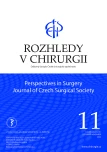Sternotomy in thyroid surgery
Authors:
J. Šafránek 1; V. Třeška 1; V. Soukupová 1; J. Bejček 2
Authors‘ workplace:
Chirurgická klinika Fakultní nemocnice Plzeň a Lékařská fakulta Univerzity Karlovy v Plzni
1; Klinika zobrazovacích metod Fakultní nemocnice Plzeň a Lékařská fakulta Univerzity Karlovy v Plzni
2
Published in:
Rozhl. Chir., 2022, roč. 101, č. 11, s. 536-539.
Category:
Original articles
doi:
https://doi.org/10.33699/PIS.2022.101.11.536–539
Overview
Introduction: A bulky retrosternal goiter means for the surgeon to consider an extracervical approach, usually from a partial sternotomy.
Methods: Retrospective evaluation of a group of thyroid operations requiring sternotomy in a ten-year period (year 2012–2021), in an attempt to predict the need for sternotomy.
Results: We performed a total of 1254 thyroid operations, with partial sternotomy required in 11 cases (0.88%): in 6 women and 5 men aged 43–84 years (mean 73.1 years). For these, 3 total thyroidectomies and 6 hemithyroidectomies (lobectomies) were performed. In 2 cases, we operated on the mediastinal residue, or regenerate, after a previous thyroidectomy from the cervical approach. The duration of hospitalization was 5–14 days, once there was bleeding with the need for operative revision, otherwise the procedures were without complications, including phonation. The border of the lower part of the thyroid gland in relation to the upper border of the aortic arch was in the range of +20 to -22 mm. The mean was -8.5 mm.
Conclusion: All sternotomy thyroidectomies performed by us had a close relationship to, or overlapped with the upper line of the aortic arch. Significantly retrosternal propagating goiters are mostly eufunctional (81.9 % in our group) and develop in patients in the seventh or eighth decade of life. Therefore, if only one lobe propagates intrathoracically, a hemithyroidectomy is sufficient. A carcinoma is rarely present; in one case in our group. We believe that the necessity of sternotomy cannot be accurately predicted, but it is necessary to be prepared for it, especially in the case of a goiter exceeding the level of the aortic arch. In case of greater retrosternal propagation, it is certainly appropriate to perform a CT, for surgical reasons (possibility of sternotomy, risk of leaving part of the gland) and anesthetic reasons (compression and deviation of the trachea).
Keywords:
thyroidectomy – sternotomy – substernal – goiter
Sources
1. Di Crescenzo V, Vitale M, Valvano L, et al. Surgical management of cervico - medias-tinal goiters: Our experience and review of the literature. Int J Surg. 2016;28;Sup-pl1:S47−53. doi:10.1016/j. ijsu.2015.12.048.
2. Batori M, Chatelou E, Straniero A. Surgical treatment of retrosternal goiter. Eur Rev Med Pharmacol Sci. 2007;11(4):265−268.
3. Pemberton HS. Sign of submerged goitre. Lancet 1946;248 : 509.
4. De Filippis EA, Sabet A, Sun MRM, et al. Pemberton’s sign: Explained nearly 70 years later. J Clin Endocrinol Metab. 2014 June;99(6):1949–1954. doi:10.1210/ jc.2013-4240
5. Jukič T, Kusič Z. Image in endocrinology. Pemberton’s sign in patient with substernal goiter. J Clin Endocrinol Metab. 2010;95(9):4175. doi:10.1210/jc.2010 - 0944.
6. Casella C, Pata G, Cappelli C, et al. Preoperative predictors of sternotomy need in mediastinal goiter management. Head Neck 2010;32 : 1131–1135. doi:10.1002/ hed.21303.
7. Coskun A, Yildirim M, Erkan N. Substernal goiter: when is a sternotomy required? Int Surg. 2014;99(4):419−425. doi:10.9738/ INTSURG-D-14-00041.1.11.
8. Haller A. Disputationes anatomica selectae. Gottingen, Vandenhoeck 1749 : 96.
9. White ML, Doherty GM, Gauger PG. Evidence-based surgical management of substernal goiter. World J Surg. 2008;32 : 1285–1300. doi:10.1007/s00268 - 008-9466-3.
10. Vadasz P, Kotsis L. Surgical aspects of 175 mediastinal goiters. Eur J Cardiothorac Surg. 1998;14(4):393−397. doi:10.1016/ s1010-7940(98)00204-8.
11. Brichon P-Y, Porcu P, Moreau-Gaudry A, et al. Extraction of substernal goitre using an innovative vacuum device. Eur J Cardiothorac Surg. 2012 Jul;42(1):178–179. doi:10.1093/ejcts/ezs018.
12. Šafránek J, Třeška V, Skalický T, et al. Diferencovaný mikrokarcinom štítné žlázy − aktuální pohled. Rozhl Chir. 2020;99 : 497 – 501. doi:10.33699/PIS.2020.99.11.497-501.
13. Švorcová M, Libánský P, Fialová M, et al. Retrosternální struma. Rozhl Chir. 2020;99 : 492–496. doi:10.33699/ PIS.2020.99.11.492–496.
14. Janík J, Malý V, Lazanská V, et al. Intratorakální struma – nediagnostikovaná – přece odoperovaná. Rozhl Chir. 2010;89(11):663−665.
15. Dvořák J, Neumann J. Chirurgické léčení velkých retrosternálně zasahujících strum. Rozhl Chir. 1994;89 : 123–126.
16. Hall TS, Caslowitz P, Popper C, et al. Substernal goiter versus intrathoracic aberrant thyroid: a critical difference. Ann Thorac Surg. 1988;46(6):684−685. doi:10.1016/s0003-4975(10)64734-0.
17. Katlic MR, Wang CA, Grillo HC. Substernal goiter. Ann Thorac Surg. 1985;39 : 391 – 399. doi:10.1016/s0003-4975(10)62645 - 8.
18. Allo MD, Thompson NW. Rationale for the operative management of substernal goiters. Surgery. 1983 Dec;94(6):969–977.
19. Cohen JP. Substernal goiters and sternotomy. Laryngoscope 2009;119 : 683–688. doi.org/10.1002/lary.20102.
20. Randolph GW, Shin JJ, Grillo HC, et al. The surgical management of goiter: part II. Surgical treatment and results. Laryngoscope 2011;121 : 68–76. doi:10.1002/ lary.21091.
Labels
Surgery Orthopaedics Trauma surgeryArticle was published in
Perspectives in Surgery

2022 Issue 11
Most read in this issue
- Pancreatic cancer in chronic pancreatitis – the diagnostic and therapeutic dilemma; an overview of cases
- Současný stav chirurgické léčby chronické pankreatitidy v České republice
- Latex and silicone drains in surgery − is the ban on rubber drains really a step forward or rather a step back?
- Historical overview of surgical procedures for chronic pancreatitis
